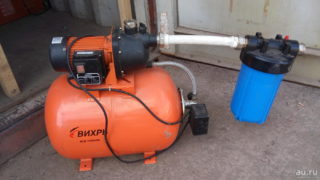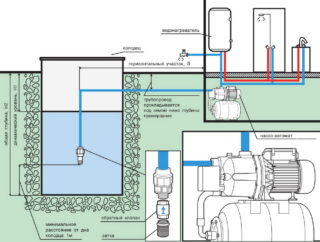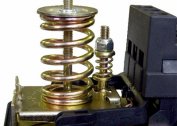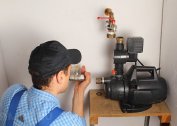With the help of a pumping station, it is possible to organize a full-fledged water supply system - the pumping equipment will maintain constant pressure in it. This will allow you to use any household appliances - a boiler, a washing machine, because the pressure in the system will be constant. The service life, as well as the quality of the device, depends on how correctly the calculations are carried out and the place for installation is selected. The pump station does not like moisture, which accelerates the formation of rust and shortens the life of the installation.
The process of installing and connecting the pumping station
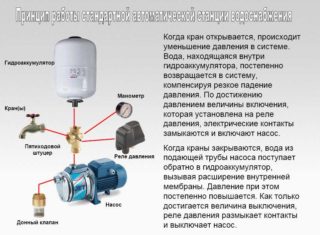 You can assemble the pumping equipment yourself, you can buy a ready-made unit and quickly connect it to the pipes. Main elements:
You can assemble the pumping equipment yourself, you can buy a ready-made unit and quickly connect it to the pipes. Main elements:
- a submersible or surface pump that raises water from a well or well;
- a hydraulic accumulator in which the pressure is regulated, after which a signal is sent to the sensor to turn the unit on or off;
- a relay that performs the function of turning the device on and off;
- pressure gauge, by which you can visually control the upper and lower pressure limits;
- pipe system through which the pump station is connected to the water supply.
For long-term and safe operation of the device in purchased models there is a system of sensors that prevent idling, as well as overheating of the structure. Homemade pumping stations are rarely equipped with such devices, so the work has to be regulated independently.
The advantage of a pumping station with a storage tank over an automatic pump is that it turns on less frequently, thereby increasing the working life. The automatic pump turns on whenever a tap is opened in the house.
Pumping stations can perform several functions:
- supply water from the well to the storage tank;
- pump fluid from the tank into the house;
- increase the pressure in the pipeline.
The tying scheme in these cases is different, but in general terms similar. Installation of pipes and distribution manifolds is carried out according to the instructions attached to the equipment.
If water is only needed at certain times of the year, it is recommended that you use a temporary pump station installation scheme. For permanent use, you need to make a stationary base, but for this you need to choose a place.
Seat selection
The basic rule for choosing an installation location is that the room should be dry and warm. Condensation forms during operation in a cool, damp place on the body and tank. It gradually destroys metal. The station must be installed in a heated basement, shed or box, located below the level of freezing.
To fix the body make a concrete pillow. This is especially important if the pumping station is located in a caisson next to a water source. Based on the technical characteristics of the equipment, the most suitable place is chosen. If the pump can lift the liquid from a depth of up to 7 meters, its installation in a caisson will be justified, since the depth of the chamber itself is usually more than 2 meters. This saves power if the distance to the water mirror is 9 meters.
You can build a place directly in the well, but in this case it will be difficult to repair or maintain the device. It is necessary to do so in such a way that at least one person can fit near the station, and can go down there with metal brackets.
A caisson or a well is the best choice of installation location if the device is very noisy.It is not advisable to place it in the house, as the sound of the motor will be heard anywhere in the house.
Calculations when choosing a model
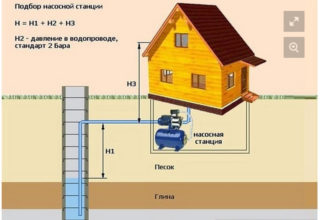 In order for the unit to cope with the task, its power is calculated depending on the number of plumbing devices, as well as water points besides the plumbing - a washing or dishwasher, boiler, heating boiler. It matters how many residents are in the house and how much water is consumed during rush hour - morning and evening, when everyone is at home.
In order for the unit to cope with the task, its power is calculated depending on the number of plumbing devices, as well as water points besides the plumbing - a washing or dishwasher, boiler, heating boiler. It matters how many residents are in the house and how much water is consumed during rush hour - morning and evening, when everyone is at home.
If the water intake point is far from home, such a parameter as the pressure of the water or the height of the water column is important. Each meter vertically is 10 meters horizontally. For example, the depth to the water mirror is 4 meters, and the distance to the house is 30 meters. In this case, the station should create 4 + 3 = 7 meters of water.
One of the main parameters of the station is productivity. This indicator should be less than the productivity of the well, otherwise the pump will pump out all the water and may burn out due to dry running.
Power is of secondary importance. First you need to check the productivity of the well. To do this, make a complete pumping of water and measure its volume.
A well in a section may have a great depth, which is not the strength of a surface pumping station. In this case, it is better to choose a submersible pump and connect it to the membrane tank located on the surface using a pipe system. Such equipment pumps water from any depth and does not create noise. Difficulties may arise when the unit breaks down, since it will have to be lifted to the surface, so it’s better to immediately buy a high-quality pump with a long service life (on and off cycles) or install a pump station with an ejector.
Tools and materials
To connect the pumping station to the water supply system, a polypropylene pipe with a diameter of 32 mm is used. One end is connected to the unit, the second is lowered into the well. A strainer is put on the end of the pipe to prevent sand and dirt from entering the motor. It is also necessary to provide a check valve, which prevents the drainage of fluid back into the well.
For work you will need:
- couplings for arranging pipe turns;
- wrenches in the set;
- rubber mat to reduce the impact of vibrations on the concrete pad, which may collapse over time;
- American crane to connect the station to the pipes - input and output, 2 pieces are needed;
- flax and paste sealant for pipe joints.
It is necessary to calculate the length of plastic pipes with a margin, since unforeseen obstacles and a foundation can arise on the way to the house, which will require the use of more materials. It is recommended to perform as few turns and bends of the trunk as possible, as this reduces the performance of the water supply. The more straightforward the pipes are laid, the less problems with operation and maintenance, the more economical the consumption of materials for inspection and inspection wells in cornering areas.
Installation technology for various schemes
The connection scheme of the pumping station to the storage tank is rarely used, since the technology has many disadvantages. Hydraulic accumulators with a rubber membrane inside are used. They allow you to make a supply of water, but the pressure in the system does not drop, unlike large tanks. If you still need a large tank, you can connect the pump station to a tank of water using a polypropylene pipe with a diameter of 32 mm.
Installation of equipment begins after laying water pipes and preparing a place for the unit.
- Secure the station to a site with a rubber mat. Screw the legs with anchor bolts, preferably not cheap Chinese, since they quickly break from vibration.
- Connect the American faucet to the lower outlet of the body, then through a metal corner with a pipe, at the end of which put a filter and a check valve.
- Connect the second upper outlet to the water pipes. Here you will need a second tap, a coupling that is soldered to the pipe for tightness.
- Check the operation of the equipment. First, fill the line with water that goes into the well, the accumulator and the pump. Connect to the network.
After the water flows into the house, you can fill up the street water supply with soil, having previously insulated it with stone mineral wool or an electric cable.
Errors and solutions
Mistakes most often occur due to unnecessary savings. The absence of filters or protection sensors reduces the service life of the pumping station, since solid particles create friction in the internal parts and they wear out faster. Water in the ground can change its depth due to movements of the earth's crust. If the sensor is not installed against dry running, the motor will burn out from overheating.
You can not cover the station with insulating materials - they have very low thermal conductivity, so the motor will not be able to cool and burn. Pipes in the ground, located above the freezing level, must be covered, otherwise traffic jams will form in the winter, which can cause the line to break.
In the presence of a large number of turns and bends of the water main, the pipes should be of a larger diameter so that the performance of the station and the water system does not suffer.
Connect the pipe segments with high quality, otherwise a leak will appear at the joints at some point. Part of the vibration is transmitted to the pipes, which reduces their tightness.
To extend the life of the rubber membrane, the air pressure in the battery and in the membrane must be adjusted before switching on and operating the pump station. If there is little air, use a bicycle or machine pump for pumping. Otherwise, the rubber will stretch unnecessarily and will soon tear or lose elasticity.
